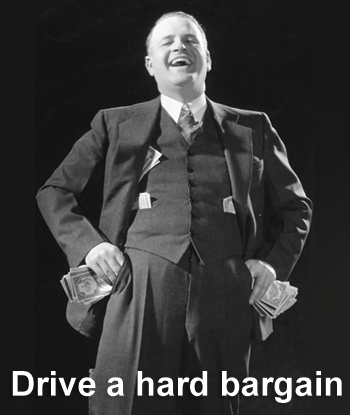If you're thinking of buying a new boat, follow these rules and you can't go wrong
• Speak to the boss
Many dealers are run by a couple of regulars and rely on temporary staff at boat shows (think chinos, blue shirts and Oakleys). These young guys and gals may be very personable but they won’t know the boats intimately, nor will they be aware of what deals can be struck. If you’re serious about buying, then have a word with the head honcho.
• Let the spreadsheet take the strain
Buying a boat is as complicated as signing up for a mortgage. Every company offers something slightly different, making like-for-like comparisons a nightmare. One handy tool can be an Excel spreadsheet. Enter all the variables, extras and costs and you’ll build up a document that should help you see the wood for the trees.
• Extras! Extras!
The cost of extras can add tens of thousands to the price of your boat. Be clear about what you want and whether you want it factory fitted. Some items are easier to install during build, saving time and money, but it can be much cheaper for your local yard to fit other extras after delivery. Some dealers will offer a package of extras.
• Decide what sort of boat you are looking for and you’ll save yourself a lot of looking around
That’s the advice from Ulf Mattsson of Malö Yachts in Sweden. “Work out whether you want a centre or aft cockpit or a deck saloon. Then you’ll need to decide where you’ll be using the boat – in protected coastal waters or offshore. Decide whether you want a boat that will be able to take you anywhere or whether you are willing to upgrade further down the line.”
When looking at manufacturers, remember different nationalities consider different elements of yacht design to be more or less important. “British buyers may focus on the nav station,” explains Ulf. “American buyers may pay more attention to the size of the fridge because of their climate, while protected cockpits can be essential to Scandinavians.”
Deciding what you want on the inside will dictate how big the boat is on the outside. If you have to have three cabins and two heads then don’t look at boats under 35ft. If you can afford a bigger boat, don’t be put off because you’ve only a small crew. “Powered winches, in-mast reefing, bow-thrusters and windlasses all make larger yachts easier to handle,” says Ulf.
• Charter before you choose
A test sail is all well and good but a two- hour jaunt won’t give you a real idea of how the boat handles or what she’s like to live aboard. Can you use the heads at sea? Does the stern slap while you sleep? Is she a dream in light airs but a pig in a blow?
To answer these and similar questions you’ll need to spend some time at sea. Look into chartering the same model. Many owners help cover the costs by chartering their craft and a trawl of the internet may reveal a boat that you can hire for a few hundred pounds. Not a bad investment before spending tens of thousands.
• Dodge the tax
It’s not easy but there are various ways to avoid paying VAT on your new yacht. Perhaps she’s going to be an asset of your company or maybe you won’t be keeping her in home waters. Some French and Italian banks offer ‘marine leasing’ schemes that reduce the tax that has to be paid but delay ownership of the boat until the end of the leasing period. Talk to the RYA, the British Marine Federation or your accountant for more information.
• Make the trial worthwhile
Learn as much as possible during your trial. This may mean doing a series of unseamanlike things to see how the boat behaves. Imagine being aboard in heavy weather.
• Buy an old new boat
Allow your new boat to be put on display at a boat show and you’ll receive a worthwhile discount. Some brokers will pay for berthing and maintenance if they can use the boat for sailing demos.
• Keep an eye on the build
There’s often a waiting list for new boats as some are only built to order. Most builders will allow you to visit the factory and see your yacht take shape. The more you are paying, the more you can get involved. The more interest you take and the more questions you ask, the better your boat will be.
The credit crunch is being felt among UK brokers, who are telling clients not to hold out for that extra £10-20,000. Turn up with cash and the odds are good of squeezing the price.
“Many yards’ standard terms and conditions are very one-sided in favour of the manufacturer,” cautions James Lawson, a partner with marine lawyers, Hill Dickinson. James accepts that it is harder to renegotiate the contract for relatively low-value production yachts than for superyachts worth millions but insists that there’s still a need to be thorough. “You wouldn’t buy a property worth hundreds of thousands of pounds without having a lawyer look at the contract so at the very least study the terms and conditions very carefully,” he advises.
Standard new boat contracts are available from the Royal Yachting Association (RYA) and it makes sense to compare these with those being offered by manufacturers. “Demand a detailed specification and clarify exactly what is included in the purchase,” says James. He also recommends establishing a precise delivery date with the boatbuilders and trying to build a provision into the contract that will provide recompense if the build is delayed.
• Check the warranty
Warranties are another area where you might need to fight for your rights and demand a change to the terms and conditions. “Ensure the warranty period lasts as long as possible and that any repairs carried out under warranty are themselves guaranteed for the same period.” James also advises to check both the yard’s insurance and your own to make sure the boat is covered at every stage: “The vast majority of new boat purchases go through without a hitch. Additional protection can be expensive and there is a balance to be struck between caution and risk. Buyers should at least be aware of the risks they are exposed to.”
• Play the markets
These are volatile times in the world money markets and this can work for or against you. Fluctuating currency markets can add or remove thousands of pounds from the price of your boat. If the Euro is strong it may be another reason to buy British. If you’re investing a lot of money in a foreign-built boat, then consider insuring (or hedging) against major currency fluctuations.
• Protect your investment
Boatbuilders and brokers go bust — it’s a fact of life. Work out how much you can afford to lose and make sure you never put more than this at risk. There are plenty of ways to minimise the danger but none of them is failsafe. Paying in instalments as the boat is built is a way of spreading the cost — but at what point does the boat become yours? If not until 100% of the price has been paid, then you’re still at risk. Builders and brokers should use client accounts but there is little to stop them raiding these. An escrow account allows for the money to be kept by a third-party until all contractual obligations are met.
• Don’t trust the bureaucrats
All new boats sold in Europe have to meet safety standards set out in the Recreational Craft Directive (RCD). Yachts are classed in four categories depending on where they can be sailed. Category A is the highest ‘Ocean’ standard while Category D denotes ‘Sheltered’. These categories can be useful in giving an idea of where vessels were designed to sail but should not be seen as a guarantee of seaworthiness. Some Category A yachts are true ocean cruisers and built to survive gales in the open ocean. Others may survive Force 8 winds and four-metre waves as stated in the RCD but being aboard them at the time would be horrific — they are simply not as capable as some of the better-built boats in the category. The way the directive works also means that some smaller boats within Category B are actually more seaworthy than larger craft in Category A. Take the whole thing with a pinch of salt.
The Royal Yachting Association represents boat users in the UK. Adult membership costs from £40 a year and gives access to a huge pool of knowledge. Members can telephone a range of experts for advice, access online information and receive discounts on books and services.
• Buy in bulk
“Don’t buy in dribs and drabs from different suppliers,” advises Graham O’Donnell after buying his new Discovery 55. “If you’re going to be spending a fair amount of money fitting out your new boat then get organised, draw up a list and ask for quotes from several places. We got 15% discounts by buying in one go.”







